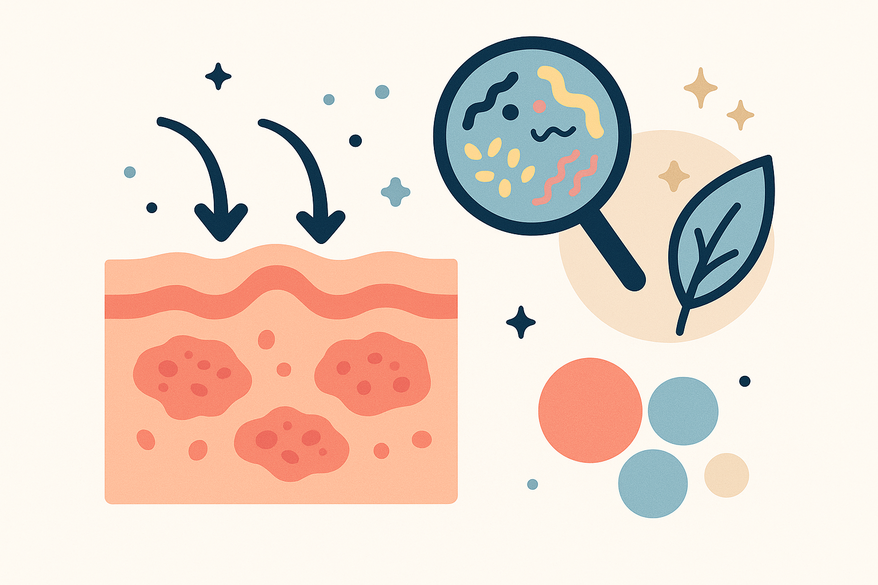How Bacteria Affect Skin Rashes: The Microbiome’s Role in Inflammation and Healing
Understand how bacteria affect skin rashes by exploring the microbiome's role in inflammation and healing, and discover strategies to manage skin health.

Estimated reading time: 8 minutes
Key Takeaways
- A balanced skin microbiome is essential for preventing and resolving rashes.
- Beneficial commensals like Staphylococcus epidermidis defend against pathogens by outcompeting them and triggering antimicrobial peptides.
- Pathogens such as Staphylococcus aureus can breach the skin barrier, produce toxins, and fuel inflammation.
- Gentle, pH-balanced skincare and targeted treatments help restore microbial balance.
- Emerging therapies—including probiotics and bacteriotherapy—offer promising strategies for rash management.
Table of Contents
- Background on Skin Rashes
- The Skin Microbiome and Key Bacteria
- Mechanisms: How Bacteria Trigger and Worsen Rashes
- Factors Influencing Bacterial Impact
- Preventative Measures and Management Strategies
- Conclusion
Background on Skin Rashes
A skin rash is any visible change in color, texture or appearance. Common signs include:
- Redness
- Swelling
- Itching
- Burning
- Flaking
- Pain or blistering
Typical causes range from allergic reactions (contact dermatitis) to viral (shingles), fungal (athlete’s foot), and bacterial infections (impetigo), as well as autoimmune conditions like psoriasis and eczema, and environmental irritants such as harsh chemicals or rough fabrics.
Infections driven by bacteria play a leading role in several rashes. For instance, impetigo often involves Streptococcus pyogenes or Staphylococcus aureus, while eczema patches can become colonized by S. aureus, exacerbating inflammation and itch. Understanding these links starts with recognizing the bacterial factors at play (PMC study).
The Skin Microbiome and Key Bacteria
Your skin hosts a vast community of microbes—bacteria, fungi and viruses—that bolster your defenses by:
- Strengthening the physical barrier
- Modulating your immune response
Two key bacterial players:
- Staphylococcus epidermidis (beneficial)
- Competes with pathogens for space and nutrients
- Induces antimicrobial peptides to kill harmful microbes
- Forms protective biofilms on healthy skin
- Staphylococcus aureus (pathogenic)
- Overgrows when commensals decline
- Releases exotoxins and superantigens that inflame skin
- Breaks down the barrier with lipases and proteases
Mechanisms: How Bacteria Trigger and Worsen Rashes
Barrier Disruption
Bacterial enzymes degrade skin lipids and corneocytes, weakening the stratum corneum and letting irritants and microbes penetrate (PMC study).
Toxin Production
S. aureus secretes exotoxins (e.g., α-hemolysin) that kill cells and superantigens (e.g., TSST-1) that hyperactivate immune cells, leading to redness and swelling (JCI article).
Immune Activation
Pattern recognition receptors (TLRs) detect bacterial components like peptidoglycan, triggering cytokines (IL-1, TNF) that drive inflammation, itch and pain (PMC study).
Examples in common rashes:
- Atopic dermatitis: Elevated S. aureus correlates with flare severity.
- Impetigo & cellulitis: S. pyogenes uses streptolysin to damage tissue.
- Acne vulgaris: Cutibacterium acnes lipases fuel comedone inflammation.
Curious about your own skin’s microbial profile? Try the Skin Analysis App for a quick visualization of key bacterial contributors.

Factors Influencing Bacterial Impact
Individual responses to skin bacteria vary widely. Key factors include:
- Genetic & Immune Differences
- Variations in TLRs and antimicrobial peptide production alter susceptibility.
- Lower defensin levels can let pathogens thrive.
- Environmental Conditions & Hygiene
- Humidity and temperature shifts change which bacteria dominate.
- Over-sanitizing removes commensals; under-cleaning allows pathogens to build up.
- Underlying Skin Conditions
- Barrier defects in atopic dermatitis or psoriasis provide niches for harmful microbes.
- Damaged skin is more easily colonized by pathogens.
Preventative Measures and Management Strategies
Maintain a Healthy Microbiome
- Use mild, pH-balanced cleansers; avoid harsh soaps.
- Avoid over-washing, which strips protective lipids and AMPs.
- Incorporate probiotic or prebiotic skincare to boost helpful bacteria (clinical trial evidence).
Prevent Harmful Bacterial Growth
- Clean and dress cuts promptly; monitor for redness or pus.
- Limit routine antibacterial soaps to preserve commensals and curb resistance.
Treatment Options
- Topical or oral antibiotics for confirmed infections—use under medical guidance.
- Bacteriotherapy trials, such as Roseomonas mucosa on atopic skin, have shown rash improvement (clinical trial evidence).
- Manage underlying conditions with emollients, topical steroids or immunomodulators to restore barrier and microbial balance.
Conclusion
Maintaining bacterial balance on your skin is key to controlling rash risk, severity and healing. When commensals like S. epidermidis thrive, they outcompete pathogens and calm inflammation. Conversely, when pathogens such as S. aureus dominate, they disrupt barriers, release toxins and ignite immune reactions. By understanding these mechanisms, you can:
- Support your skin’s microbiome with gentle, pH-balanced care
- Identify early signs of bacterial overgrowth
- Leverage targeted treatments—from antibiotics to innovative bacteriotherapies
Consult a dermatologist for persistent or severe rashes and keep an eye on emerging probiotic skincare trials. Armed with these insights, you can work with your skin’s microbial allies to prevent bacteria from turning a minor itch into a major concern.
FAQ
- Q: Can normal skin bacteria really protect against rashes?
A: Yes. Beneficial commensals like S. epidermidis compete with pathogens for space and nutrients, and they secrete antimicrobial peptides that neutralize harmful microbes. - Q: When should I see a doctor for a rash?
A: Seek medical advice if a rash is accompanied by fever, spreading redness, pus, severe pain or if it persists despite over-the-counter remedies. - Q: Are antibacterial soaps helpful for rash prevention?
A: Routine use can be counterproductive. Antibacterial products may strip away beneficial commensals and contribute to resistance. Gentle, pH-balanced cleansers are preferable. - Q: What are bacteriotherapy and probiotic skincare?
A: Bacteriotherapy involves applying beneficial bacteria (e.g., Roseomonas mucosa) to the skin to restore balance. Probiotic skincare uses topical formulations to support commensal populations. - Q: How can I maintain a healthy skin microbiome daily?
A: Use mild cleansers, avoid over-washing, choose pH-balanced products, and consider prebiotic/probiotic formulations under dermatological guidance.





